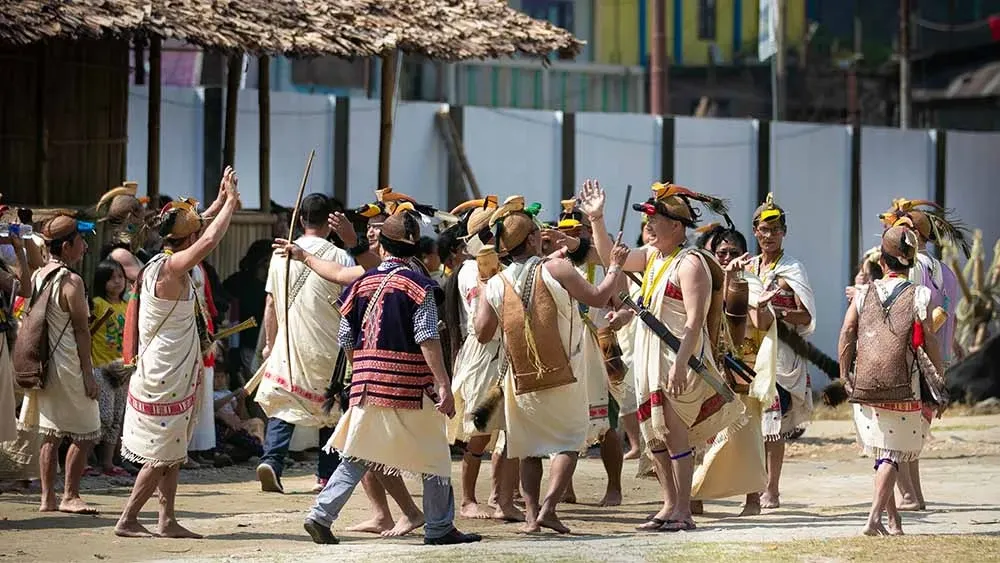Arunachal Pradesh, the northeastern stone of India, is a land of enveloping beauty, diverse traditions and a rich cultural heritage. lie close in the Eastern Himalayas, this “Land of the Dawn-Lit Mountains” congratulate oneself pure landscapes, local tribes, and centuries-old traditions that have been carefully protect. In this blog post, we take ship on a journey through the cultural silver of Arunachal Pradesh, go through into its traditions, festivals, crafts and heritage.
The Indigenous Tribes:
Pillars of Arunachal’s Culture Arunachal Pradesh is home to 26 major tribes and over 100 sub-tribes, each with its unique customs, local language and traditions. The major tribes include the Nyishi, Apatani, Adi, Monpa and Galo, among others. These tribes form the backbone of the state’s cultural identity.
1. Nyishi Tribe
The Nyishi tribe, primarily found in the central and western regions of Arunachal Pradesh, is known for its rich cultural heritage and vibrant traditions. With a strong connection to nature, the Nyishi people have a deep reverence for their environment, often practicing agricultural activities like rice cultivation and horticulture. Their traditional attire, adorned with intricate designs, reflects their vibrant cultural identity. The Nyishi also celebrate various festivals with colorful dances, rituals, and feasts, fostering community unity and preserving their unique way of life. The tribe plays an important role in the diverse tapestry of Arunachal Pradesh’s indigenous communities.

2. Apatani Tribe
The Apatani people, live in the Ziro Valley, are celebrated for their supportable agricultural practices and unique facial tattoos. Their terrace farming technique is a UNESCO-recognized agricultural heritage. Festivals like Myoko, celebrated with custom and community convention, reflect their strong connection to nature.

3. Monpa Tribe
The Monpa tribe of Tawang district is closely linked to Tibetan culture. Their vibrant festivals, such as Losar (Tibetan New Year), and skill in wood fashion and Thangka painting, highlight their artistic skill.

4. Adi Tribe
The Adi people, primarily live in the Siang region, are known for their warrior spirit and involved traditional take shape work. Solung, their agricultural festival, showcases their deep ties to the land.

Festivals of Arunachal Pradesh:
Celebrating the Spirit of Arunachal Pradesh festivals in Arunachal Pradesh are not just celebrations but also a reflection of the tribes’ long-lasting traditions and recognition for nature.
1. Losar Festival
The Monpa tribe celebrates Losar to mark the Tibetan New Year. This 15 – day festival includes religious rituals, vibrant dances, and celebration meal, represent the arrival of spring.
2. Si-Donyi Festival
Celebrated by the Tagin tribe, Si-Donyi is dedicated to Si (Earth) and Donyi (Sun). The festival involves traditional dances, prayers, and custom to pray to favour for success.
3. Ziro Music Festival
While modern in essence, the Ziro Music Festival is a global attraction. It is a meeting of music, nature, and culture, held between the attractive Ziro Valley.
Art and Craft of Arunachal Pradesh:
The art and craft of Arunachal Pradesh are as diverse as its tribes. Each tribe contributes to the state’s artistic heritage through unique techniques and materials.
1. Handloom and Textiles
The weaving techniques of the Adi, Apatani, and Mishmi tribes are remarkable. Their fabrics, add ornament to with geometric patterns and vibrant colors, are a visual treat. The traditional dresses of the Monpa, including the involved woven Chuba, are iconic.
2. Wood Carving
The Monpa and Wancho tribes excel in wood fashion, creating masks, model, and religious artwork that reflect their spiritual beliefs.
3. Bamboo and Cane Work
Arunachal Pradesh is known for its beautiful bamboo and cane products. Baskets, mats, and furniture crafted by the tribes are both functional and artistic.
Architectural Heritage:
Arunachal Pradesh’s architectural heritage is deeply influenced by its ground and climatic conditions. Traditional houses are built using locally available materials like bamboo and wood.
1. Monasteries
The Tawang Monastery, Asia’s second-largest, is a beacon of Tibetan Buddhism. Its cool feeling, complex painting, and historical significance make it a cultural gem.
2. Tribal Villages
The traditional houses of tribes like the Apatani are built on stands to modify the hilly land. These houses are not just shelters but also a monument to supportable living.
Cooking:
The cooking of Arunachal Pradesh is a very pleasant mix of flavors, heavily influenced by the availability of local ingredients. Rice, bamboo shoots and boil foods are mains.
1. Pika Pila
A popular pickle made from bamboo shoots, Pika Pila is a favorite among the Apatani tribe.
2. Thukpa
This Tibetan noodle soup, improve with vegetables and meat, is a comforting dish during the fresh winters.
3. Apong
A traditional rice beer make by various tribes, Apong is an basic part of celebrations and social assembly/meeting.
Nature and Spirituality:
The tribes of Arunachal Pradesh have a great respect for nature, viewing it as a source of food and spirituality.
1. Animism
Many tribes follow life beliefs, worshipping natural elements like the sun, moon, and rivers. This respect for nature is clear in their pattern and festivals.
2. Sacred Groves
Sacred groves are patches of forests protect due to their religious significance. They are home to rare green and animal group, highlighting the tribes’ ecological awareness.
Challenges and Preservation:
Despite its rich cultural heritage, Arunachal Pradesh faces challenges in protect its traditions. Urbanization, migration, and external influences alarm the accuracy of tribal practices. However, efforts by the government, NGOs, and local communities are ensuring the documentation and rally of these traditions.
1. Cultural Festivals
State-sponsored festivals like the Arunachal Pradesh Tourism Festival provide a platform for tribes to showcase their culture to the world.
2. Education and Awareness
Introducing cultural studies in schools and promoting traditional crafts among the youth are steps toward take care of heritage.
Frequently Asked Questions (FAQs)
1. What is the significance of festivals in Arunachal Pradesh?
Festivals in Arunachal Pradesh are fundamental to the culture of its domestic tribes. They celebrate the seasons, honor immortal, and strengthen community bonds. For instance, the Losar festival marks the Tibetan New Year, while the Ziro Music Festival showcases modern and traditional music.
2. Why is the Tawang Monastery famous?
The Tawang Monastery is the largest monastery in India and the second-largest in Asia. It is a center of Tibetan Buddhism, known for its architectural greatness, ancient the Good Book, and cool climate.
3. How can tourists experience the culture of Arunachal Pradesh?
Tourists can attend festivals like Losar and Ziro Music Festival, explore tribal villages, visit religious community, and engage with local skilled worker to experience the state’s vibrant culture.
4. What steps are being taken to take care of the culture of Arunachal Pradesh?
Efforts include promoting traditional crafts, organizing cultural festivals, and incorporating tribal studies in educational curriculums. NGOs and the government play a key role in protect and showing the heritage.
Conclusion
Arunachal Pradesh is a living magazine of India’s cultural diversity. Its vibrant festivals, complex crafts, and melodic happening with nature make it a silver library of heritage. Exploring this state is not just a journey through amazing landscapes but also a deep dive into the traditions and values that define its people. As we celebrate and maintain these cultural silver, we contribute to the legacy of this delightful land for generations to come.



